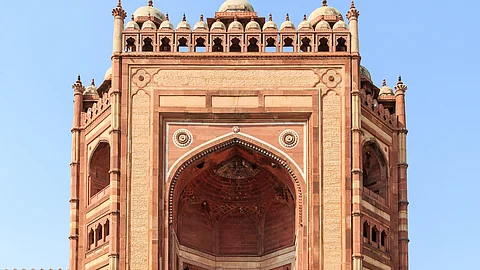
- Destinations
- Experiences
- Stay
- What's new
- Celebrating People
- Responsible Tourism
- CampaignsCampaigns
- SubscribeSubscribe
- Buy Now

While the magnificent Taj Mahal holds the key attention of the tourists in Agra, 37 kms southwest of the city lies a place memorable in the Mughal annals -- a town called Fatehpur Sikri. Each monument takes you to the glorious past, showcases the rich heritage and leaves you spellbound --- weaving a fascinating story of courage, prosperity and religious harmony.
The well-planned city is almost in ruins, but the mark of royalty and splendour is everywhere --- it takes you back in time to imagine the period of Mughal rule.
As history goes, the town was founded by the Mughal emperor Akbar in the 1500s. The ruler was blessed with a baby boy after a long struggle and this was believed to be the inspiration behind his founding the town. It is believed that the child was conceived under the blessings of Sufi saint Sheikh Salim Chisti, who lived in the village of Sikri. The emperor on considering it as an auspicious land had made it his capital. Later, it was named Fatehpur Sikri, meaning 'the City of Victory'.
Visiting the town nearly every year since I was 15, walking amidst the royal palaces of the king and his wives, and hearing the evergreen Mughal tales make the place reverberate with memories.
Constructed on the southeast end of an artificial lake, the town is slightly elevated in position to the City of Taj and is surrounded by a wall on three sides. A short winding road leads one to two important structures, the royal palaces and the Jama Masjid (one of the largest mosques in India). With prominent influence of local and Persian style, the main building of Fatehpur Sikri has been built with red sandstone and marble.
As one enters the place, there are many historical buildings to marvel at. First, is Jodhabai's palace which was home to King Akbar's Hindu wife Jodha. The palace which lies on the eastern side shows a fusion of Indo-Mughal architecture. The palace is built on a rectangular plot and has several animal and bird motifs marking the walls of the palace.
Our next destinations are the Diwan-e-aam and Diwan-e-Aam. The former is a hall of public audience and towards the north is Diwan-e-Khas, house of private audience. The hall has a beautifully carved central column inspired by Persian architecture, and is also known as the Jewel House, because it was the seat of Akbar's Navratnas or nine talented individuals from different fields.
Another attraction at Fatehpur Sikri is the tomb of Salim Chisti, which faces south, towards the Buland Darwaza (the victory gate). The only structure made of marble in this red building, it is the burial place of the reverred saint Salim Chisti.
The entrance to the main chamber bears Quranic verses. Every year tourists come in a great number to tie threads on the walls of the tomb with a belief that just like Akbar, their wishes shall also be heard and fulfilled. With Sufi singers sitting across the tomb, their melodies fusing with the sanctity of the place, Fatehpur Sikri will make you feel closer to divinity.
Fatehpur Sikri is 37 kilometres from Agra, which is easily accessible by road from Delhi.
Agra is the nearest airport, which is 7 kms from the city centre and 3 kms from Idgah bus stand. It only takes 40 minutes to travel from Delhi to Agra by road.
The main railway station is the Agra Cantonment station. It is well connected to all major cities of India.
Idgah bus stand is the main bus stand in Agra and you can get buses for Delhi, Jaipur, Mathura, Fatehpur Sikri and all major cities.
